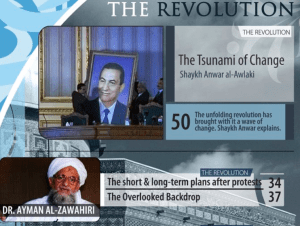 And you thought print was dead. The latest contender in the current-affairs magazine market carries the innocuous title Inspire, and the cover art of its fifth edition, Spring 1431 (or 2011 if you follow the infidel calendar) would not look out of place on the New Age self-help shelves of your news agent. But its publisher, al-Malahim Media, may be looking for a more, uh, kinetic audience. That’s because al-Malahim is, in fact, an affiliated of Al-Qaeda in the Arabian Peninsula, and the sort of inspiration promoted by the title is of a decidedly destructive sort. Indeed, the magazine approvingly quotes terrorism expert Bruce Reidel’s assessment of its prospects: “They’re not looking to outdo the readership of the Economist or TIME magazine. They only need to inspire one or two people to blow something up in the right place and they’ll make back their start-up costs.”
And you thought print was dead. The latest contender in the current-affairs magazine market carries the innocuous title Inspire, and the cover art of its fifth edition, Spring 1431 (or 2011 if you follow the infidel calendar) would not look out of place on the New Age self-help shelves of your news agent. But its publisher, al-Malahim Media, may be looking for a more, uh, kinetic audience. That’s because al-Malahim is, in fact, an affiliated of Al-Qaeda in the Arabian Peninsula, and the sort of inspiration promoted by the title is of a decidedly destructive sort. Indeed, the magazine approvingly quotes terrorism expert Bruce Reidel’s assessment of its prospects: “They’re not looking to outdo the readership of the Economist or TIME magazine. They only need to inspire one or two people to blow something up in the right place and they’ll make back their start-up costs.”
Weighing in at a hefty 70 pages (above is the beginning of its sizeable table of contents), some of it is pretty sophisticated propaganda, engaging directly with arguments that question the legitimacy of al-Qaeda’s ideology and claims about political change in the Muslim world. Plainly, it’s aimed at readers living in Western countries – who, if seduced by the argument, will be capable of putting together sophisticated plots. Indeed, an email from one reader purporting to ask how to make contact with the jihadists as a “walk-in” in countries like Pakistan or Yemen is advised, instead, to set up a cell and plot attacks in the Western countries where he currently resides. To this end, Inspire even offers a training manual, “Open Source Jihad” that includes weapons and tactics guidelines that “allows Muslims to train at home instead of risking dangerous travel abroad.”
The magazine’s youthful feel — slugs written in a font that evokes marker-drawn lettering of hip-hop graffiti, for example — and high production values evident in the layout and use of photographs underscores this reaching for a sophisticated audience of potential jihadists based in the West.
Like its “competitors” in the news magazine market, Inspire focuses heavily on the Arab rebellion, and it’s cover story on “The Tsunami of Change” is also written by the movement’s most noted English-speaking TV pundit, of sorts — Anwar al-Awlaki, the Yemeni-American cleric whose YouTube sermons have inspired a number of DIY terrorists on these shores, and upon whom President Obama ordered a hit last August. It also features a boring commentary by Al-Qaeda number 2, Ayman al-Zawahiri, supporting Arab rebellion but arguing that violence must remain an essential element, and argues, in an echo of classic Leninism, that protest movements need to be guided by a vanguard party ready to seize opportunities.
Awlaki, the marquee name pundit, is definitely clearer than the others, who rattle on for pages about the Arab rebellion without saying much. The Yemen-based Jihadist cuts to the quick, pooh-poohing the idea that the Arab rebellions are a setback for Al-Qaeda: Those rebellions have broken the barrier of fear, he argues, and they’ve swept away some of al-Qaeda’s bitterest enemies in the Arab world. Even though the jihadists are not leading any of those rebellions, at the very least, they’ll gain breathing space from the fall of regimes that had ferociously hounded al-Qaeda types. Even if they don’t come to power, the jihadists will find themselves in a stronger position to consolidate themselves once autocrats like Mubarak — and even Gaddafi and Assad — are removed, he argues.
He certainly has a point. But the real question is how receptive young men who have taken to the streets to free their countries will be to a jihadist message, once they’ve opened up the democratic space that creates new alternatives to both dictatorships and extremism.
Inspire is an impressive effort, although after a sassy front-of-book section it sags into boring doggerel in the well — except for the illustrated guide on how to strip a Kalashnikov, of course. Still, coming out with a print magazine is a bold venture when any printing press known to reproduce it would be subject to a drone strike. Needless to say, it runs no advertising. And “print” may be a relative term — it’s not clear that this beautifully designed and laid-out magazine exists beyond PDF form disseminated online. In keeping with the stay-at-home jihad theme, the idea presumably is for apprentice-mujahedeen throughout the West to print it out at home and share with their friends. No word yet on a tablet edition.

